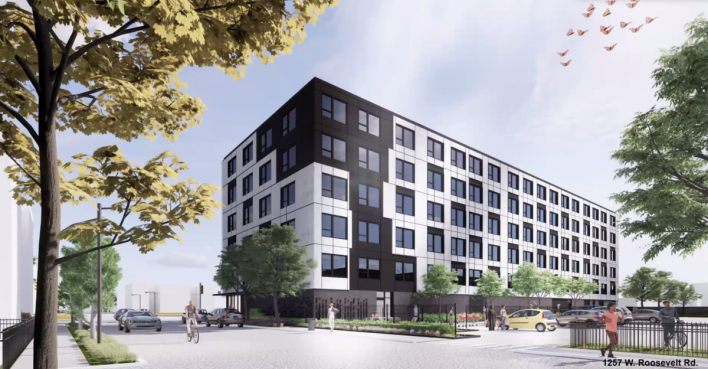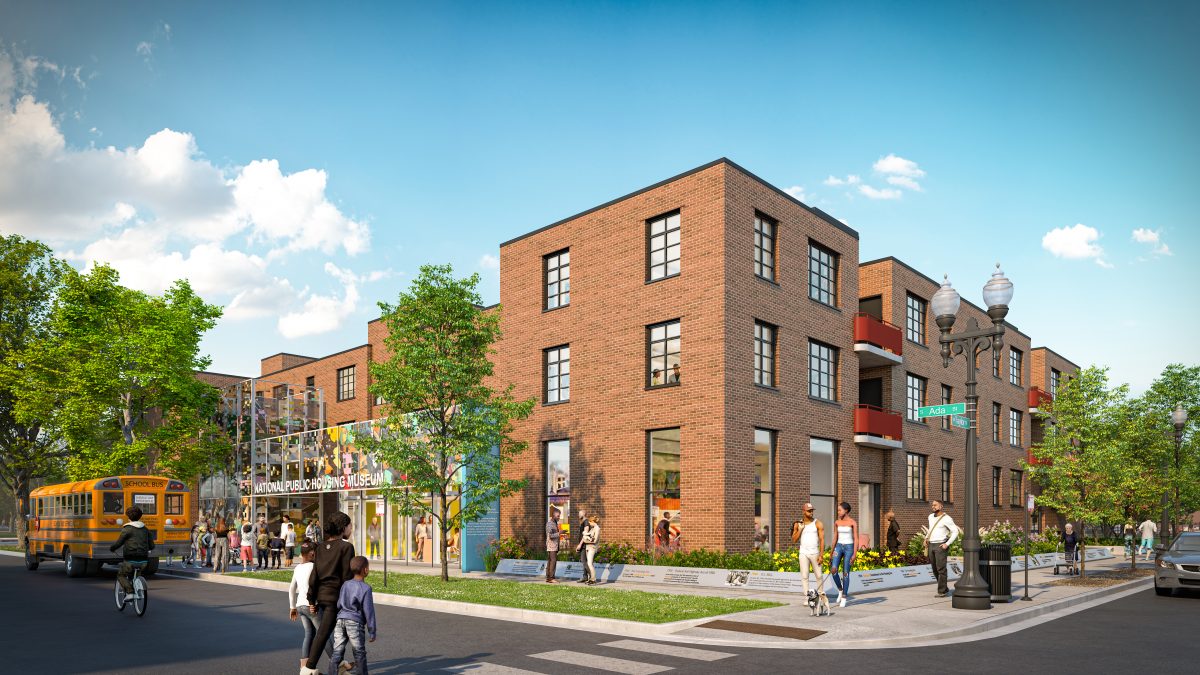ABLA homes (Jane Addams Homes, Robert Brooks Homes, Loomis Courts, and Grace Abbott Homes) were a Chicago Housing Authority public housing development that comprised four separate public housing projects on the Near-West Side of Chicago. The developments were constructed between the late 1930s and mid 1950s. Altogether these housing developments contained nearly 3,600 housing units and provided homes for 17,000 residents. The vast majority of these housing units were demolished between 2002 and 2007. Currently only 330 original units remain as part of the Brooks Rowhouses.
The Chicago Housing Authority created a redevelopment plan for ABLA homes titled Roosevelt Square. The Roosevelt Square plan calls for 2,441 housing units to be built over several phases. According to the Chicago Housing Authority, Phase 1 was completed in 2006 and consisted of 181 new CHJ and affordable rental Units, 233 affordable and market rate condominiums and townhomes, and 15,000 square feet of new retail on Taylor Street. Currently Phase 2 is under construction and will consist of 185 new CHA and affordable rental units, 247 affordable and market rate condominiums and townhomes, a new park, and new retail.
Alders Jason Ervin (28th) and Bryon Sigcho-Lopez (25th) hosted a community meeting on March 11th during which Related Midwest and the CHA detailed plans for the next phase of development, expected to be completed by 2023. According to a Block Club Chicago report on the meeting by Mauricio Peña, the development team and the city outlined Related Midwest's plans to rehab 184 apartments from a previously completed phase and build 222 apartments across four buildings. The unit mix includes studios and one-, two- and three-bedrooms made up of market-rate, affordable and CHA units.
CHA currently owns property at 1002 S. Racine Ave. At this address Related Midwest would build a six-story building with 67 apartments and 34 parking spaces. This would replace a vacant lot currently used for parking. 50 of the apartments would be market rate while the remaining 17 would be CHA units. The property would also contain a fitness center, indoor and outdoor amenity space, and 12,000 square feet of retail space along Taylor Street.
At 1257 and 1357 W. Roosevelt Rd., Related Midwest is proposing 70 apartments at each site. The development would include a fitness room, outdoor amenity space, a dog run, and 41 parking spaces.

The fourth building would be a partnership between Related Midwest and the National Public Housing Museum. According to the museum’s executive director, Lisa Lee, the museum will house public art from international artists, award-winning exhibits, history, and cultural gathering spaces as well as programs. Developers will restore the facade of the existing building at 925 S. Ada St. for the museum and create 15 apartments. The 15 units will be equally divided; five market rate, five CHA, and five affordable units.
In total, the four buildings will include 97 market rate units, 80 CHA units, and 45 affordable units.
Residents are excited to see plans move forward but some are concerned there won't be enough affordable housing nor enough opportunities for low-income families to become homeowners. One neighbor said, “We don’t want to just live in an apartment. We want to be able to live in a house,” according to Block Club. There appears to be two camps that emerged during the community meeting: those who feel there is too little affordable housing and those who feel there should be more market rate housing.
Another neighbor asked why there was no focus on single family homes or townhomes, Block Club reported. Related Midwest president Curt Bailey said the company hasn't been able to figure out a viable financing formula for those types of developments yet. CHA representative Robin Broman told residents that the city and Related Midwest are working on the next phase of Roosevelt Square and that it will contain market rate and “affordable ‘choose to own’ homes.” Broman added, “The CHA is not walking away from choose-to-own. We are very passionate about providing that to our residents.”
While neighbors welcome the prospect of more residents in the community, some are worried that the developments do not have enough parking and that there is insufficient infrastructure to support “so many” new residents. The building locations are about 10-15-minute walk from the Racine Blue or Polk Pink stations, which should help reduce parking demand. It's also worth noting that the sites are only two or three miles southwest from the center of the Loop, which means that car-free commutes to downtown jobs will involve relatively little travel time.
Others speculated that the developments would reduce property values. Developers and city officials stated there is no proof of affordable housing driving down property values. Housing Commissioner Marisa Novara is quoted by Block Club as saying, “We do not have research or any evidence that shows that affordable housing brings down property values. I want to be very clear that as the story gets repeated and people hear it as fact, that it is not fact. We do not have evidence of that.”
Additionally, neighbors have concerns about whether or not the plan has had enough community input and that it’s being presented as a done deal. Alderman Ervin told neighbors that there will be more opportunities to provide input and that the presentation was designed to gather community feedback. Ervin is quoted as saying, “This will not be the last conversation as it relates to this development that is spanning two wards. Let’s also remember that the land we are speaking of is the land that belongs to the Chicago Housing Authority….People have rights...to return back to this particular community that they were displaced.”
It’s great that the city of Chicago is making good on its promise to restore CHA housing, albeit at a very slow pace. I hope that the city will address residents' concerns about parking with facts: there are lots of people who want to live car free or simply can’t afford a vehicle. The infrastructure arguments seem a bit weak given that there are other parts of the city with higher rates of density and infrastructure is meeting their needs just fine. Lastly, I hope the city and CHA will offer sufficient opportunities for home ownership for CHA residents.





